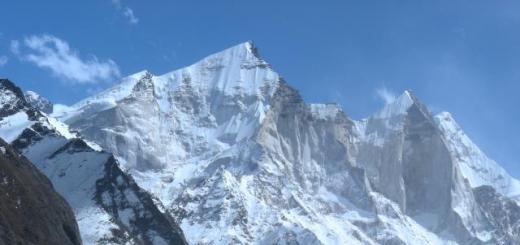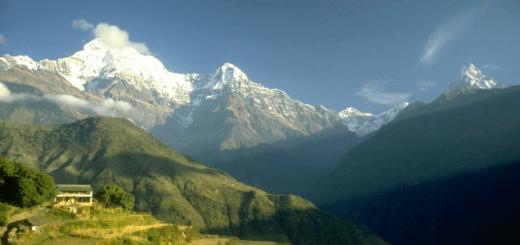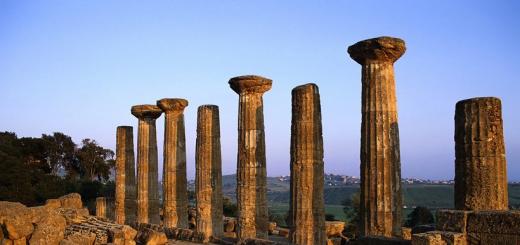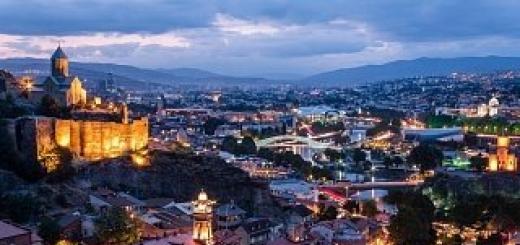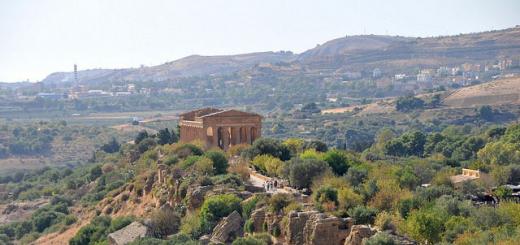Taj Mahal is probably the most famous and most attractive tourist site in India. And it is clear why - he is stunningly beautiful. He is a miracle. Many people want to see it, and from 3 to 5 million tourists visit it every year. Although from a formal point of view, the Taj Mahal represents not Indian, but Persian architecture. But it was he who became the hallmark of India.
As you know, the Taj Mahal was built at the behest of the king of the Mughal empire Shah Jahan in memory of his beloved wife Mumtaz Mahal, who died in her 14th childbirth.
Yes, by today's standards I would not give birth to this child, there are already more than enough children. And they would live happily ever after.
But then who would have known about the 3rd wife of the fifth Mughal padishah. And so the inconsolable Shah Jahan (which means "lord of the world") ordered to build a tomb for his beloved. Which was built over 20 years (from 1630 to 1652) by about 20,000 workers under the guidance of architects from all over the Muslim world. Up to a thousand elephants and many horses and oxen were used to transport goods in construction.
Snow-white marble was brought for construction over 300 km, and other materials for the construction of the tomb were delivered not only from all over India, but also from abroad.
When the Taj Mahal was built, the problem of dismantling scaffolding and auxiliary structures was solved, just like after the construction of our Winter Palace. Namely, they allowed the surrounding residents to pick up these materials for free. Which was done in a very short time (according to legend - in one night).
The names of the architects who led the creation of the miracle are known. These are Deshenov-Anu, Makramat Khan and Ustad Ahmad Lahauri. The Persian Lakhauri is usually considered the main author of the project. According to another version, the Turk Isa Mohammed Efendi was the chief architect.
There is a legend that the masters who performed the miracle were blinded and their hands were cut off so that nothing like this could be done. But it seems to be just a legend, there is no evidence for it.
So much was spent on the construction of the Taj Mahal that the treasury was practically empty, and the huge and richest state of the Mughals began to decline. I doubt it. Painfully rich country India.
However, after the completion of the construction, Shah Jahan was overthrown by his son Aurangzeb and imprisoned. The construction of the same, but black mausoleum, symmetrical to the white one, on the other side of the Janma River, was stopped. About the black mausoleum, many researchers say that this is just a legend. But agree, beautiful. And judging by the obsession of the creators of the mausoleum with the idea of symmetry, and plausible.
Aurangzeb, although he kept his father in prison for 20 years, nevertheless buried him next to Mumtaz Mahal, his beloved wife and his mother. And Shah Jahan's tombstone, which is larger than Mumtaz Mahal's tombstone, is the only thing not symmetrical in the fully symmetrical Taj Mahal.
But the pitiful story that Shah Jahan spent 20 years in captivity in the Red Fort, looking out of the window at the mausoleum of his beloved, is just a legend. Yes, he was imprisoned in the Red Fort, but not in Agra, but in, 250 km from Agra.
The Taj Mahal, as the Mughal state declined, also began to slowly fall into disrepair.
The British, who captured India after the Mughals, even though they were civilized and educated, were slowly picking out semi-precious stones from the walls of the mausoleum. And with them, his golden spire was replaced with an exact bronze copy.
After India gained independence, the Taj Mahal became the most important museum, and in 1983 it was declared a UNESCO World Heritage Site.
Due to the excess concentration of harmful substances in the air, marble darkens. But every year the Taj Mahal is cleaned, and, to my untrained eye, it looks great. The shallowing of the Janma River and, as a result, the subsidence of soils at the base of the mausoleum causes concern.
And further. Hindu nationalists say that the Taj Mahal is not an Indian work, that it was built on the site of a destroyed Hindu temple and therefore it should be demolished. How serious this is, is evidenced by the fact that the Vice Prime Minister of the Indian Republic had to visit the Taj Mahal and after that make a statement that it is very beautiful and, since it was built by the Indians, it is an Indian creation.
Excursion to the Taj Mahal
The morning was somewhat foggy. What was alarming, because they write on the Internet that in winter you can not see the Taj Mahal at all because of the fog. As one tourist wrote: “I could only feel it.”
We were brought on a bus with an electric motor to the box office of the Taj Mahal. Cars with internal combustion engines cannot be used there, so as not to pollute the air.
We bought tickets, for foreigners they cost 1000 rupees, this is the most expensive excursion on the tour "".
We were checked no less strictly than when boarding an airplane, with passing through the frame and feeling.
At the entrance there are huge red gates with 11 small turrets. This is a characteristic feature of Muslim buildings in India: the walled courtyard can be entered through gates with turrets.
After passing through a relatively small arch, you finally come to the Mausoleum. Here is the first miracle: when you go through the arch, the Taj Mahal seems huge and occupies the entire opening, and when you go out, you see that it is far away, and it seems small. This is where the first "ah" comes in.
To the Taj Mahal, you walk along an elongated rectangular pool, the bottom of which is painted blue. That's why the water looks blue. Water, we must pay tribute, is transparent, which is very difficult to achieve in the tropics. But the bottom of the pool is not very clean.
The paths leading to the mausoleum are lined with low cypress trees, and mowed lawns are laid out along them. They say that initially rose flower beds were laid out here, and lawns are already an English innovation. The English do not know anything more beautiful than smooth lawns, but here, I think, roses would be better.
The Taj Mahal is best viewed from afar. What can I say: a miracle - it is a miracle, it must be seen.
Before you go up to the mausoleum itself, you need to put on the white shoe covers issued when buying a ticket.
When you approach, the seams between the marble blocks become visible, the minarets become like ordinary lighthouses. The Taj Mahal is not perceived in parts, it does not fall apart. It must be seen in its entirety.
From the high platform paved with marble slabs around the mausoleum, the unattractive Dzhamna River with muddy water is visible. The river from the side of the mausoleum and from the opposite bank is fenced with barbed wire. When we were there, a dead cow lay in the water near the shore. They say that now it will not work to admire the Taj Mahal from the other side. “The army lives there,” the guide said.
But the Taj Mahal is also beautiful. Impressive patterns of marble and mosaics of semi-precious stones. Decorate the walls and elegant Arabic inscriptions.
Photography is not allowed inside the mausoleum. But I did not understand this and took several shots until they told me. However, there is nothing special inside. There are 2 tombstones, a larger one - the Shah, a smaller one - Mumtaz Mahal. Light penetrates through the openwork marble gratings, but it is not enough. Inside is darkness.

A great love story: Shah Jahan and Mumtaz Mahal
Every year, the Taj Mahal in India is visited by about five million tourists. The creation of the greatest structure on Earth is associated with the name of Shah Jahan, the grandson of the great Mogul Akbar.
The name Shah Jahan, which means "ruler of the world", was given to his beloved son Khurram by his father. Even at a young age, the boy was engaged to Mumtaz Mahal, but it so happened that they fell in love with each other. And their love has passed the test of eternity ...
Shah Jahan had a large harem, but for him there were no other women except Mumtaz Mahal. Yes, he had children from other wives, but his feelings for these women could not be compared with his great love for the "chosen one of the palace" - this is how the name Mumtaz Mahal is translated. The fact that they were very close is recorded in all the palace chronicles, which is unusual for the Eastern world. After all, different kinds of love are preached among Muslims: love for God, for the ruler, for the country, but not romantic.
The happiness of the lovers did not last long. An uprising broke out in one of the remote provinces, and Shah Jahan went to suppress it. In all campaigns, Mumtaz Mahal accompanied her husband. But this trip was very difficult for her - she was pregnant. The birth was very difficult, and on June 17, 1631, after the birth of her fourteenth child, she died.
Shah Jahan's grief cannot be described in words. He did not leave his chambers for 8 days, did not eat anything and did not talk to anyone. During this time, he is very old and gray.
History of the creation of the Taj Mahal

According to legend, shortly before her death, Mumtaz Mahal asked her husband to build the most beautiful mausoleum in the world. This was the only thing that Shah Jahan could now do for his beloved ...
The construction of the Taj Mahal began in 1632, six months after the death of Mumtaz Mahal, and lasted twelve years. Huge amounts of money were spent on this project. The Taj Mahal is the most expensive structure ever built. About 32 million rupees was spent on the construction, which is now comparable to billions of euros. For the cladding of the building, the purest marble in the world was used, which was mined in the province of Rajasthan. Shah Jahan forbade the use of this marble in other construction sites of the Indian Empire.
Because of the construction, famine began in the country: part of the grain that was intended for the provinces was sent to the construction site to provide food for the workers.
The construction of the Taj Mahal was completed in 1643. After that, the reign of Shah Jahan continued for quite a long time - until 1658. But it could not be called successful. The empire found itself in a very difficult economic situation. The son of Shah Jahan and Mumtaz Mahal deprived his father of power. Shah Jahan spent the rest of his life in the Red Fort, from the window of which he constantly looked at the tomb of the woman who became the love of his life ... The great Mughal ruler was buried next to his beloved wife.
Secrets of building the Taj Mahal
The Taj Mahal has been striking in its beauty for more than three hundred years. It can rightfully be called one of the most grandiose structures in the history of mankind. The ideas and solutions that were used in its construction are simply amazing! Especially when you consider that the Taj Mahal is several centuries old. But it is perfect in its beauty and precision. Where is the Taj Mahal and why is it worth visiting?
- The Taj Mahal is located in the city of Agra (about 250 km from Delhi) on the banks of the Jumna River. This place was not the most convenient for the construction of such a structure: the ground is unstable due to the proximity of water. Therefore, a unique technology was used, which is still used now only in a slightly modified form (for example, the use of piles in the construction of skyscrapers in the UAE).
Workers dug deep wells that passed through the groundwater layer. These wells were filled with stones and lime mortar. Stone columns were erected on this foundation, connected to each other by arches. The foundation slab of the building was placed on this structure.
- When designing the Taj Mahal, some optical illusions were used. To get to the territory of the Taj Mahal, you need to go through the arch of the entrance gate, through which the visitor sees the building for the first time. As you approach the arch, it seems that the Taj Mahal is moving away. Conversely, when the visitor leaves, he sees through the arch, as if the structure is approaching. This creates the effect that a person takes the Taj Mahal with him.
- It seems that the amazingly beautiful minarets of the Taj Mahal are located strictly vertically. But even here it was not without an optical trick! In fact, they are slightly deflected away from the building. If they stood strictly vertically, it would seem that they are leaning towards the mausoleum. But there is another advantage hidden in the chosen slope. In an earthquake, the minarets would have collapsed to the sides of the Taj Mahal without hitting it.
- The Taj Mahal combines the best elements of memorials built earlier by the representatives of the Mughal dynasty: minarets, a dome, four corner towers and four portals.
- The tomb, which is located under the main dome of the Taj Mahal, is not the actual burial place of Mumtaz Mahal. Her real tomb is located in a secret marble hall under the mausoleum. This was done so that no one would disturb the peace of the “chosen one of the palace”. The Qur'an says that one should not disturb the peace of the deceased.
Pietra fool
The decoration inside the Taj Mahal is made according to the Pietra Dura technique, which came to India from Italy. Amazing stone flowers made of gems adorn the walls of the halls and other elements of the building. Therefore, the Taj Mahal inside looks like a jewelry box.

At present, this art of stone cutting can be seen in Indian workshops. And the technology has not changed at all over the past few centuries.
Religious symbolism of the Taj Mahal
The Taj Mahal depicts the earthly and afterlife in accordance with the ideas of Islam. The whole complex is divided into 2 parts. The earthly part consists of bazaars and caravanserais, and the afterlife consists of the Garden of Eden and the mausoleum. The pond and the entrance gate, located between these two parts, symbolize the transition from one world to another.
The color scheme of the Taj Mahal is also very symbolic. The buildings of the earth part are made of red sandstone. White color is used only for the mausoleum and symbolizes spirituality and faith.
There are eight halls in the mausoleum, which symbolize the eight gates of paradise described in the Koran and one central one - it houses the tomb of Mumtaz Mahal.
What tourists need to know
The whole complex is surrounded by a secure wall, and at the entrance, visitors are carefully checked for prohibited items: food, lighters, cigarettes, chewing gum, mobile phones. So it's better to leave them at the hotel.
Photo: Wikipedia, Muhammad Mahdi Karim, Vetra,
Inside the mausoleum there are two tombs - the shah and his wife. In fact, their burial place is in the same place as the tombs, but underground. The time of construction refers to approximately 1630-1652. The Taj Mahal is a five-domed structure 74 meters high on a platform, with 4 minarets at the corners (they are slightly tilted away from the tomb so as not to damage it in case of destruction), which is adjacent to a garden with fountains and a pool. The walls are made of polished translucent marble (which was brought to the construction site 300 km away) with inlaid gemstones. Turquoise, agate, malachite, carnelian, etc. were used. More than 20,000 craftsmen from all over the empire were invited to build the complex. A twin building was supposed to be located on the other side of the river, but it was not completed.
The mausoleum has numerous symbols hidden in its architecture and layout. So, for example, on the gate through which Taj Mahal visitors enter the park complex surrounding the mausoleum, a quotation from the Koran is carved, addressed to the righteous and ending with the words "enter my paradise." Considering that the words “paradise” and “garden” are spelled the same in the Mughal language of that time, one can understand the intention of Shah Jahan - building a paradise and placing his beloved within it.
A beautiful story about the history of the creation of the Taj Mahal
http://migranov.ru/agrastory.php
For 22 years (1630-1652), more than twenty thousand people, including the best architects and architects of India, Persia, Turkey, Venice and Samarkand, built this airy lace marble monument of the love of the Muslim Mughal king Shah Jahan ("master of the world") to to his wife Arjumand Bano Begum, who received the name Mumtaz Mahal during the coronation, which means "the chosen one of the court."
They got married when she was 19 years old. He only loved young Mumtaz and did not notice other women. She gave birth to her master 14 children and died giving birth to the last child.
For a long time, the Taj Mahal was the tallest building in India, its height, together with the main dome, is 74 meters.
Unfortunately, this recognized masterpiece of world architecture is gradually falling into decay - there are no more doors made of silver, a parapet of gold, fabric studded with pearls on the tomb of the beautiful Mumtaz. Scientists believe that the towers of the minarets tilted dangerously and could fall.
And yet, this miracle has existed for 355 years.
Taj Mahal is the most grandiose and mysterious architectural monument dedicated to love. Today this mosque is recognized as a new wonder of the world and is under the protection of UNESCO. This famous building is located in India and has no analogues in the world. Thousands of pilgrims come here every year, who are captivated by the romantic story of its creation. Read the creation of the Taj Mahal (India, Agra) in this article: interesting facts, photos, convenient visiting times and, of course, an unforgettable love story.
Taj Mahal - love story
From the love story that caused the construction of the attraction, you need to start getting acquainted with this mausoleum in India. The history of creation says that the Taj Mahal mausoleum-mosque was built by order of Shah Jahan, the ruler and emperor of the Mughal Empire. Great grief befell the great ruler, in the birth of the fourteenth baby, his beloved wife died. For a whole year, the emperor could not come to terms with the loss, and then he decided to build the most majestic and beautiful tomb in the world in memory of his late wife.
Thus began the construction of the temple, which lasted for 21 years. This story of an architectural gem shows that the heart of the great ruler of an entire nation belonged to only one woman. By the way Jahan's love, Mumtaz was the third wife in the harem. The girl got into the harem to the ruler when she was 19 years old, and all the years that the spouses were together, the emperor did not cherish the soul in his wife. The architectural monument is included in the 7 wonders of the world of our time.
Construction and architecture of the Taj Mahal
It remains a mystery who built and designed the Taj Mahal. In those days, the work of architects in the Islamic world was not held in high esteem, all the laurels and the glory of the greatness of the buildings went to the customer, and therefore in the annals, in connection with the construction of the shrine, only the name of Shah Jahan is mentioned. According to historians, the main idea of the building belonged to the then-famous architect Ustad Ahmad Lahauri. It is the style of this architect that is clearly visible in the architecture of the mosque.
Construction began in the winter of 1632. The construction involved 20,000 people recruited from the subjects of the emperor and brought from neighboring states. Only the best craftsmen were honored to take part in the construction work, because according to the emperor's idea, the tomb of his beloved wife was to become perfection.
Architectural Features
The most remarkable feature of the architecture of this building is an optical illusion; it surprises not only tourists, but also eminent architects. The illusion lies in the fact that a person is used to when he approaches an object, the object increases, when it moves away, the object decreases. Here it's the other way around. As you approach the temple, it visually becomes smaller, and the closer you are, the smaller the temple. And when you step back backwards, the structure becomes larger, and as a result, it practically hangs over the person.
The building is divided into two parts, one symbolizes worldly life, the other life after death, unknown and inexplicable. These two worlds are connected by a path with a pond, which originates from the arch of the mausoleum. This is the road of transition between two worlds.
Inside, tourists are greeted by a chic octagonal hall with luxurious columns. The walls are studded with incredibly beautiful gems and gems that have been collected from all over the world. The ambassadors of the ruler also came to Russia for rare varieties of malachite and jasper. Behind a marble screen are two shining sarcophagi of the Jahan couple. In fact, these tombs are not real, the graves of the spouses are underground.
Looting the tomb
 To date, it is known that during the civil uprising of 1857, the British seized gold, which was used to decorate the spiers of the tomb. The soldiers also took out most of the precious stones from the walls of the Taj Mahal. Many argue that the looting was much larger. According to the legends, the doors made of carved jasper, as well as diamonds and Persian carpets, disappeared.
To date, it is known that during the civil uprising of 1857, the British seized gold, which was used to decorate the spiers of the tomb. The soldiers also took out most of the precious stones from the walls of the Taj Mahal. Many argue that the looting was much larger. According to the legends, the doors made of carved jasper, as well as diamonds and Persian carpets, disappeared.
Today it is impossible to say for sure what was really stolen, but after the uprising, the British Viceroy in India made every effort to restore the wonder of the world, spending a lot of money on it. To prevent this from happening again during the Second World War, scaffolding was erected around the building, which could disguise the wonder of the world and it remained untouched.
Settling Palace
 For the construction of the shrine, the builders built a special platform, which rose 50 meters above the river level. Today, under the influence of natural factors, the Taj Mahal began to subside. This causes serious concern of local authorities, because the shrine is covered with cracks and, according to many experts, it may simply collapse in a short time.
For the construction of the shrine, the builders built a special platform, which rose 50 meters above the river level. Today, under the influence of natural factors, the Taj Mahal began to subside. This causes serious concern of local authorities, because the shrine is covered with cracks and, according to many experts, it may simply collapse in a short time.
Today, numerous projects are being developed that could stop the destruction of the Taj Mahal, but there is still no consensus on how to save the shrine. There is another opinion, some archaeologists argue that there is no serious danger to the safety of the shrine. According to the results of their research, the building gave a slight settlement and over 70 years of observation, its condition remained satisfactory.
Taj Mahal, the mausoleum of Sultan Shah Jahan and his wife Mumtaz Mahal. Architect Ustad Isa. 1630-1652
Taj Mahal
The mausoleum of the Taj Mahal is located in the city of Agra in northern India, in the state of Uttar Pradesh. It was created in a style later called "mughal", which combined the traditions of Indian, Persian and Arabic architecture. Actually, the mausoleum was the first building built in the new spirit. The Taj Mahal was built at the behest of Shah Jahan (1592-1666). the fifth ruler of the Mughal dynasty, as the burial place of his wife Arjumand and a monument to their love. Arjumand was the daughter of the minister Jangir and is better known under the titles of Mumtaz Mahal (Chosen of the Palace) or Taj Mahal (Crown of the Palace).
Initially, the tomb was called Raoza Mumtaz Mahal or Taj Bibiha-Raoza, which in Arabic means "the tomb of the mistress of my heart." Only later, during the English colonization of India, the modern name of the Taj Mahal was assigned to the building.
Controversy about the architect
After the warof India by the British, a number of scientists hypothesized that the realcreatorThe project of the tomb was a European architect. Possibly ItalianGeronimo Veroneo, who worked at the court of Shah Jahan. Or frenchJeweler AGustin de Bordeaux, one of the creators of the Golden Throne of the Great Mughals.Opponentsthey object: in the architecture of the structure and construction methods there are noeuro tracesPey technical achievements of that time, but everything is connectedbetter thanowned Indian, Persian and Arabic architecture. Specificwaysstone treatments used in construction were known onlyeasternmasters. And domes, like the dome of the Taj Mahal, were erected in thatperiod lish in Samarkand and Bukhara.

LOVE IN STONE
Beloved wife of Shah Jahan died in childbirth in 1631 at the age of 38. The saddened emperor decided to perpetuate her memory in a previously unseen tomb. The ruler of one of the most powerful and richest countries of that time made full use of the opportunities
his position. He sent messengers to all centers of architecture in the Islamic world: Istanbul, Baghdad, Samarkand, Damascus and Shiraz, calling together the most famous architects of the East. At the same time, drawings and plans of all the famous buildings of Asia were brought to Agra on his order. Vladyka wanted to erect a building that had no equal or even like it in the world.
Many projects were considered. It may have been the first architectural competition in history. As a result, Shah Jahan settled on the version of the young Shiraz architect Ustad Isa.
Then began direct preparation for construction. Masons from Delhi and Kandahar, who were considered the best in India, came to Agra. Artists and calligraphers were hired in Persia and Baghdad, Bukhara and Delhi were in charge of the decoration, and skillful gardeners from Bengal were invited to create a garden and park ensemble. The management of the work was entrusted to Ustad Isa, and his closest assistants were the prominent Turkish architect Khanrumi and Samarkand resident Sharif, who created the magnificent domes of the mausoleum. Thus, the mausoleum of Mumtaz Mahal combined all the best that the architecture and arts and crafts of the East achieved at that time.

TAJ MAHAL MUSEUM
In addition to the actual architectural complex of the mausoleum on the territory of the Taj Mahal, there is also a museum exposition dedicated to the history of the Mughal dynasty. It presents a unique numismatic collection, objects of art and everyday life of the 16th-17th centuries. Near the walls of the museum there are gardens in the famous Mughal style - copies of the garden surrounding the mausoleum.
Ustad Isa took late Indian architecture as a basis, in particular the Humayun mausoleum - the burial place of the first Great Mughals and their families. But at the same time, he made significant changes, abandoning, for example, addiction to numerous columns (there are no Taj Mahal at all). According to court historian Abdul Hamid Lahori. construction began six months after the death of Mumtaz Mahal and lasted 12 years. In 1643 the central building of the tomb was completed.

The construction was completed in 1648, but, apparently,
After that, the finishing continued for several more years. In total, the construction and decoration took 22 years. More than 20 thousand people took part in the work at the same time, for whom a special town of Mumtazabad was built near Agra.
The main material was white marble, delivered on elephants from the quarries of Jokhapur - more than three hundred kilometers away. In the decoration, inlays with precious and semi-precious stones were widely used. There were Hindu Kush lapis lazuli, Chinese jade of all colors, Deccan moonstone, Persian amethysts and turquoise, Tibetan carnelian, malachite brought from Russia. According to legend, “a lot more gold and silver than an elephant can take away” went into inlay. For the main lines in the ornaments, red sandstone and black marble were used.
In order to raise materials for the construction of the main dome to a great height, according to the project of the Turkish engineer Ismail Khan, they built a sloping earth embankment 3.5 km long and almost 50 m high. Elephants could easily deliver marble blocks to the work site along it. When Shah Jahan saw the finished mausoleum, he wept with admiration.
Despite its huge size, the mausoleum looks weightless. In many ways, this effect is achieved due to the four minarets, which have a carefully planned deviation from the vertical axis. This was supposed to save the tomb from being destroyed by fragments of minarets in the event of an earthquake.

Soon, Shah Jahan wished to build a similar mausoleum next to the Taj Mahal, but already black - for himself.
However, this was not destined to come true. The emperor fell ill, a war broke out in the country between his sons. Thanks to the support of the Muslim clergy, the youngest, the Islamic fanatic Aurangzeb, won, executing all his brothers and not sparing even his own father.
Shah Jahan spent the rest of his life in the casemate of the famous Red Fort of Agra, built by his great-grandfather Akbar, the founder of the dynasty. From there he had a view of the Taj Mahal - the last consolation of the captive. According to the chronicler Abdul Hamid Lahori, feeling the approach of death, the prisoner asked the jailers to bring him to the window and, looking at the tomb of his beloved wife, "plunged into a deep, eternal sleep." According to his will, he was buried next to Arjumand.
The proportions of the Taj Mahal were so perfect that even a legend was born that during its creation they resorted to magic and the help of otherworldly forces. Another legend says that at the end of the work, the eyes of the architects were gouged out, and the hands of the craftsmen were cut off so that they could not create anything like it again. Of course, this is a myth. On the contrary, both architects and builders were generously rewarded, and besides, their work during the entire time of the construction of the mausoleum was well paid. Which, by the way, gave Shah Jahan's enemies a reason to claim that the construction of the Taj Mahal ruined the treasury of the empire. But this is not so: at that moment, the power of the Great Moguls was very rich and occupied almost the entire Hindustan. Simultaneously with the construction of the tomb, extensive irrigation work was carried out in Punjab and successful wars were waged with neighbors.

BEAUTY AND TIME
Time and people did not spare the monument. Aurangzeb was the first to destroy it, seizing the golden lattice that surrounded the cenotaph of Mumtaz Mahal. Condemning his father for senseless waste, he himself built a semblance of the Taj Mahal south of Agra - for himself and his elder wife. But the copy was very unsuccessful and almost unknown to the general public.
After Aurangzeb, the mausoleum was plundered under Nadir Shah in 1739. Then the silver doors of the main hall were taken away, later replaced by bronze doors that still exist. When the British army occupied Agra in 1803, the soldiers took out about 200 kg of gold from the Taj Mahal and dug out a lot of precious stones from its walls. Most of these treasures went to the East India Company.
Only at the end of the XIX century. By order of the Viceroy of India, Lord Curzon, the monument was taken under protection. Since then, its security has been the concern of the Indian authorities - first the colonial, and after independence - the national government. The leadership of the Department of Archaeological Surveys of India even achieved a decision of the Supreme Court of the country on the introduction of a ban on industrial activities in the vicinity of the Taj Mahal. Aircraft flights are prohibited over the mausoleum so that the vibration from the operation of the engines does not damage the unique monument.
Unfortunately, the normal functioning of the museum has been hampered by politics for several years now. In connection with the activation of terrorist organizations in India, the protection of the Taj Mahal had to be entrusted to the armed forces and special services. The central pavilion of the mausoleum was closed to visitors back in 1984, after a clash between guards and militants took place there. Since then, the Indian government has been wary of a repeat attack and has carefully controlled the surrounding area. Ironically, the attacks against the Taj Mahal, built by one of India's greatest Muslim sovereigns, were planned and carried out by Islamic radicals.
Recently, the mausoleum has also been threatened by the forces of nature. Due to subsidence of the soil, changes in the hydrological regime and several earthquakes, the foundations of the minarets have shifted, and only urgent measures to strengthen the soil saved the miracle of architecture from destruction.

Mosaic on the walls of the Taj Mahal.
Inside the walls of the Taj Mahal are decorated with mosaic images of fabulous trees and flowers. The thoughtful arrangement of windows makes the mausoleum literally transparent to sunlight and moonlight, and it almost does not need artificial lighting. In the center of the main hall there is an octagonal burial chamber topped with a low dome. Here, behind an openwork stone fence inlaid with precious stones, there are false tombs - cenotaphs. The real sarcophagi of the Empress Mumtaz Mahal and Shah Jahan are located in the dungeon exactly under the cenotaphs. These tombs are covered with fantastically vegetal ornaments made of semi-precious stones.
Taj Mahal is a pearl of world architecture. It is recognized as one of the most beautiful structures on Earth, and its silhouette is considered an unofficial symbol of India. In 1983, the Taj Mahal was included in the list of objects under the protection of UNESCO.
IDEAL PROPORTIONS
In terms of the Taj Mahal, it is somewhat similar to a classical Islamic religious building. In addition to the mausoleum itself, the complex of buildings includes a mosque and a covered gallery built of red sandstone, a gate in the form of an arch, as well as a vast garden with fountains and pools, planned so that the tomb is clearly visible from all sides.
The mausoleum was erected on a vast platform of red sandstone seven meters high, on which, in turn, a three-meter puddle was built on it and rests directly on the Taj Mahal. This absolutely symmetrical octagonal building, 57 meters high, is crowned with a 24-meter dome, shaped like a lotus bud. The facades are decorated with lancet arches and niches, creating a subtle play of light and shadow.
The mausoleum is especially beautiful against the blue sky, and all this magnificence is reflected in the rectangular pool located directly in front of the building. This is the first such experience in the world. In Europe, two years after the completion of the Taj Mahal, French architect André Le Nôtre used a body of water designed to reflect the facade of the palace.
White marble in combination with a carefully selected shade of the dome tiles - the color of the sky - creates the impression of an incredible lightness of the monumental ensemble. The beauty of the Taj Mahal is emphasized by the play of light, especially in the evening twilight, when the marble is painted in various shades of purple, pink, golden colors. Early in the morning the building, as if woven from lace. seems to be floating in the air.




